IMAGES
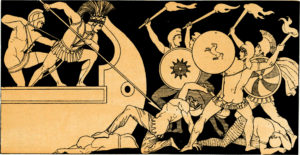
John Flaxman, “Ajax Defending the Greek Ships Against the Trojans,” 1793. Public Domain. Engraving.
John Flaxman was a British sculptor and engraver, one of the leading visionaries behind European Neoclassicism. He spent a portion of his life living in Rome, where he comissioned to illustrate the Illiad and the Odyssey by Groegiana Hare-Naylor, possibly simply as a way to fund him remaining in Rome. His engarvings for both were widely disseminated and published by Piroli in Italy in 1793, and later in England. In this engraving we see Ajax, portrayed as a bronze age warrior with a plumed horse crest, using a spear to ward off encroaching Trojans. Behind him, we see his half brother Teucer firing on them. While the helmets may be era appropriate, the shields appear anachronistic, more similar to later hoplite shields than the bronze age shields they should be. Ajax is also portrayed without his famous seven-layered shield. The engraving shows some depth perspective in the layering and shading of characters, but is otherwise limited in its realism.
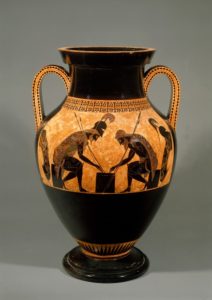
Exekias, “Black-figure amphora with Achilles and Ajax playing dice,” c. 550-525 BCE. Museo gregoriano etrusco (Vatican City). Ceramic, 61.1 cm tall.
Exekias wsa an ancient Athenian who was active in the mid- to late- 500s BCE. Art historians regard him as an artistic visionary for his fine incision work and sensative compositions, marking him as one of the greatest Attic vase painters. He used mainly black-figure artistry, carving details into blackened inlays in the vases prior to firing, a simpler method than the later red figure method. This amphora is perhaps the pinnacle of Exekias’s work, showing intricate detailing of the two central figures. It shows Achilles and Ajax playing a game using dice, depicting a moment of temporary respite during the Trojan War. Yet along with the two figures and their intricately detailed cloaks and hair, two details pop out at the viewer. One is that Achilles retains his helmet, showing that Achilles was greater than Ajax regardless of Ajax’s prowess, and the second is that Ajax’s front foot has a raised heel, showing Ajax’s fear of the greater Achilles. The helmet seen is anachronistic, a type of helmet seen during Exekias’s Greece and not Mycenaean Greece. While there is no evidence of this story existing in tradition prior to Exekias’s rendition of the scene, this vase’s new depiction was copied over 150 times in the following 30 years.
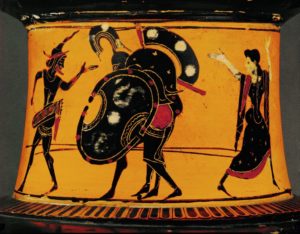
Antimenes Painter, “Amphora with Ajax Carrying the Body of Achilles, detail of the neck,” c. 520-510 BCE. Musee du Louvre (Paris). Terracotta.
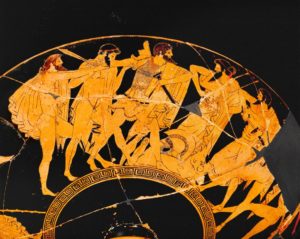
Douris Painter, “Red figure cup, side A; the arms of Achilles, draped man between warriors (Ajax, Odysseus), men, some draped, at block, voting,” c. 500-450 BCE. Kunsthistorisches Museum (Vienna). Pottery.
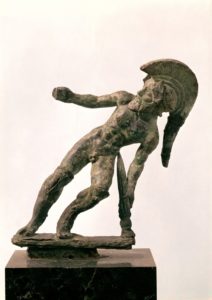
Unknown Etruscan, “Statuette of Ajax Committing Suicide,” 6th century BCE. Museo archeologico di Firenze (Florence). Bronze.